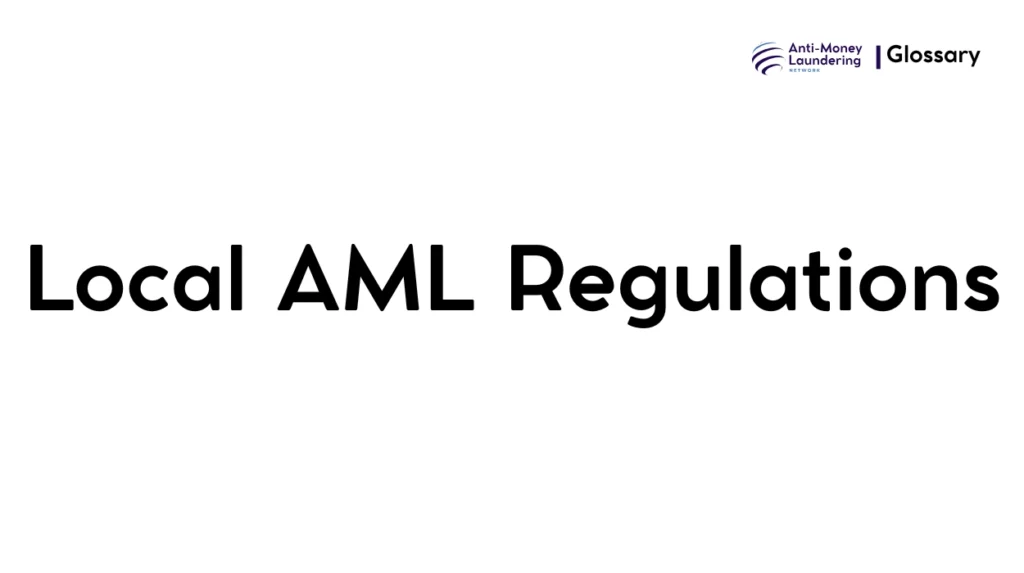Definition
Local AML Regulations refer to the specific set of laws, rules, and procedures established by national or regional authorities aimed at preventing and detecting money laundering within their jurisdiction. These regulations mandate that financial institutions and other regulated entities implement controls and compliance programs aligned with international AML standards but tailored to local legal, economic, and risk environments. They govern processes such as customer due diligence (CDD), transaction monitoring, suspicious activity reporting (SAR), and internal controls to prevent the use of financial systems for laundering criminal proceeds.
Purpose and Regulatory Basis
The primary purpose of local AML regulations is to protect the financial system from being exploited by criminals to disguise illegally obtained funds as legitimate and to prevent the financing of terrorism. These regulations align with global frameworks such as the Financial Action Task Force (FATF) Recommendations, the USA PATRIOT Act in the United States, and the European Union’s Anti-Money Laundering Directives (AMLD). They ensure adherence to international standards while addressing country-specific risks and compliance requirements. Their role is crucial for maintaining the integrity, transparency, and stability of the financial and economic environment, and for fostering public trust.
When and How it Applies
Local AML regulations apply to a wide spectrum of entities including banks, fintech firms, casinos, real estate businesses, legal professionals, and high-value goods traders—essentially, those exposed to financial crime risks. They come into effect during various stages such as customer onboarding, ongoing monitoring of transactions, and when suspicious activities are detected. For example, banks must perform CDD on new customers, continuously monitor account activity for anomalies, and report suspicious transactions to relevant authorities as per local regulatory timelines. These regulations also apply during the launch of new financial products or services involving money transmission and cross-border transfers.
Types or Variants
Local AML regulations can vary by region and sector but generally fall into these categories:
- Banking AML Regulations: Specific to banks and financial institutions covering deposit accounts, wire transfers, and loans.
- Non-Banking Financial Institutions (NBFIs): Regulations tailored for insurance companies, money service businesses, and fintech platforms.
- Designated Non-Financial Businesses and Professions (DNFBPs): Applies to professions such as lawyers, accountants, real estate agents, and dealers in precious metals.
- Sector-Specific Regulations: For gambling, real estate, and luxury goods trade where AML risks are high.
Procedures and Implementation
Institutions subject to local AML regulations must develop and implement risk-based AML programs which typically include:
- Customer Due Diligence (CDD): Verifying customer identities, understanding the nature of their business, and assessing risk profiles.
- Enhanced Due Diligence (EDD) for high-risk customers or transactions.
- Transaction Monitoring Systems: Automated systems to detect unusual or suspicious transactions.
- Suspicious Activity Reporting (SAR): Timely filing of reports with regulatory authorities on suspected money laundering.
- Internal Controls and Training: Establishing policies, appointing AML compliance officers, and ongoing staff training.
These steps are mandated to be proportionate to the assessed risk level and must be regularly reviewed and updated.
Impact on Customers/Clients
From a customer’s perspective, local AML regulations mean they must provide detailed personal and business information during onboarding and potentially during ongoing transactions. They may face restrictions such as enhanced scrutiny, slowing down of transactions, or requests for additional documentation. While these processes may impact convenience, they protect customers by reducing financial crime risks and ensuring the safety of the financial system. Customers also have rights regarding data protection and privacy under local law during AML procedures.
Duration, Review, and Resolution
Compliance with local AML regulations is an ongoing obligation. Customer risk profiles and transactions are regularly reviewed to detect new risks or suspicious activities promptly. Periodic internal audits and regulatory inspections assess the effectiveness of AML measures. Institutions must keep AML records, including CDD and SARs, for prescribed durations (often five to seven years). Any identified non-compliance issues must be promptly resolved, with remedial actions documented.
Reporting and Compliance Duties
Financial institutions and regulated entities bear primary responsibility for complying with local AML rules. They must maintain comprehensive documentation and demonstrate effective AML controls. Failure to comply can result in severe penalties including fines, license revocation, and even criminal charges. Regulators monitor compliance through audits and data requests. Institutions must also cooperate fully with law enforcement agencies during investigations.
Related AML Terms
Local AML regulations are closely connected to several AML concepts such as:
- Customer Due Diligence (CDD) and Know Your Customer (KYC) processes.
- Suspicious Activity Reports (SARs).
- Politically Exposed Persons (PEPs) and enhanced scrutiny for these individuals.
- Risk-Based Approach (RBA) to AML compliance.
- Anti-Terrorist Financing (CFT) regulations which overlap with AML.
Understanding these terms is crucial for interpreting and implementing local AML requirements effectively.
Challenges and Best Practices
Common challenges with local AML regulations include adapting to frequent legal changes, managing operational costs of compliance, and handling complex customer risk profiles. False positives in transaction monitoring and cross-border compliance issues also pose difficulties. Best practices include investing in advanced technology like AI-based monitoring, regular training programs, and internal audits; establishing clear governance frameworks; and fostering a culture of compliance within institutions.
Recent Developments
Recent trends in local AML regulations include the adoption of advanced technologies such as artificial intelligence and machine learning to improve detection accuracy, increased focus on crypto-asset AML regulations, and tighter cross-border information sharing. Regulatory bodies are also emphasizing sustainability and environmental, social, and governance (ESG) aspects linked to AML risks. Updates to global AML standards continue to influence local regulatory changes, requiring institutions to stay vigilant.
Local AML regulations are the cornerstone of effective anti-money laundering frameworks, ensuring that national financial systems comply with international standards while addressing local risks. They mandate robust procedures for customer due diligence, transaction monitoring, and reporting of suspicious activities, imposing clear compliance duties on financial institutions and related entities. Proper implementation mitigates financial crime risks, protects customers, and upholds market integrity, making these regulations vital for global and national security.

